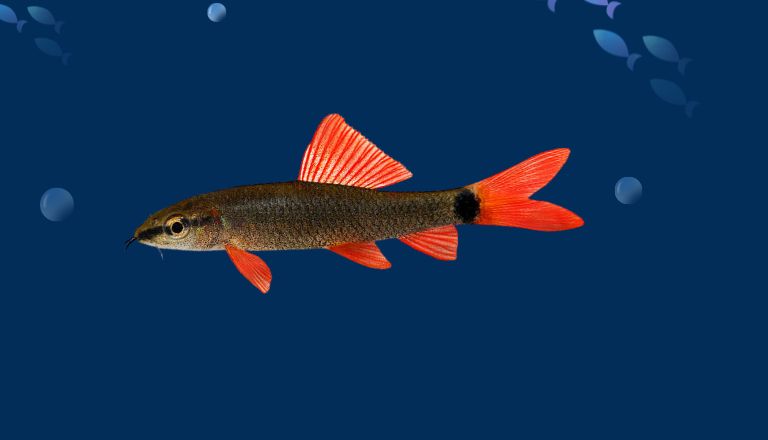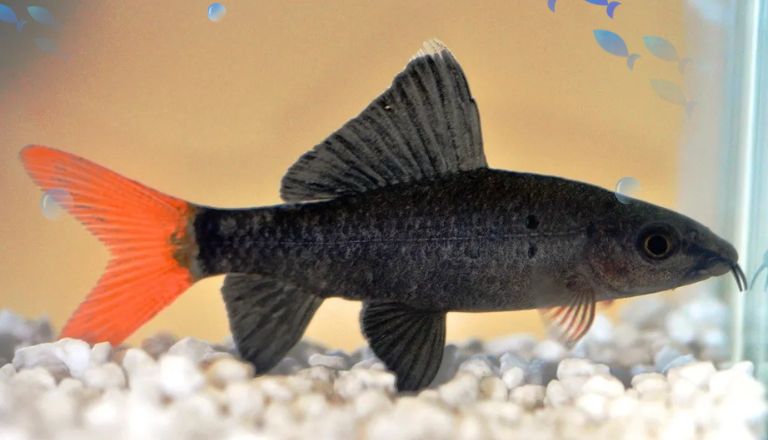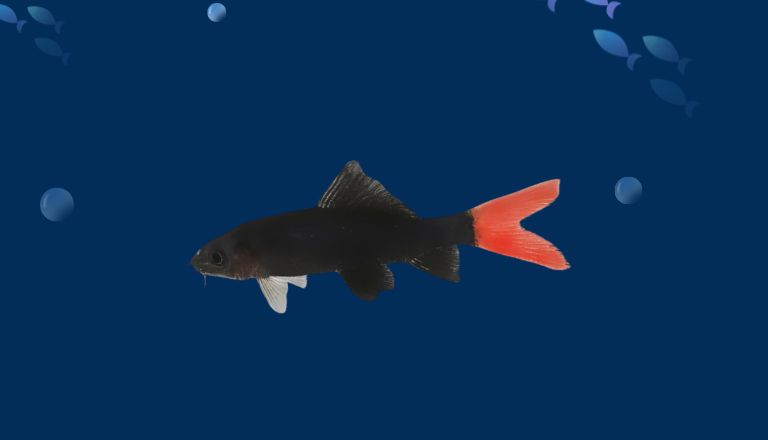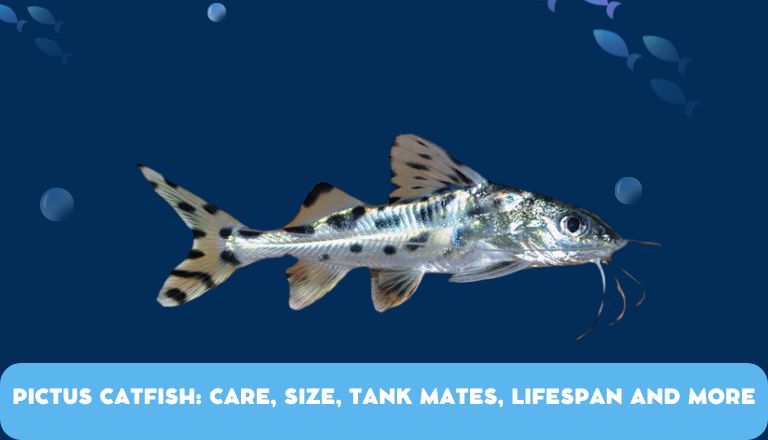Red Tail Shark Care Guide & Species Profile
The Red Tail Shark is a beautiful fish from the Cyprinidae family. A fish that commands attention with its vibrant red tail and sleek black body. With their unique look and interesting behavior. This fish is truly captivating, and you’ll love learning more about it on your underwater adventures.
Red Tail Shark Facts & Overview
Scientific name: Epalzeorhynchos bicolor
Common names Red-tailed black shark, red tail shark minnow, red-tailed labeo
Distribution: Thailand
Size: Up to 6 inches
Life expectancy: 5-8 years
Color: Black with a red or orange tail
Diet: Omnivore
Temperament: Semi-aggressive, territorial
Minimum tank size: 55 gallons
Temperature: 72° – 79ºF (22° -26°C)
pH: 6.0-8.0 pH
Hardness: 5-15 dGH
Care level: Intermediate
Breeding: Egg layer

Origin
One of the most fascinating creatures, the Red Tail Shark, also known as Epalzeorhynchos bicolor, comes from the freshwater rivers and streams in Thailand. Their native habitat has been severely threatened by water pollution, deforestation, and overfishing.
The International Union for Conservation of Nature (IUCN) has suggested conservation steps to protect this fish in its natural habitat. Campaigns about the plight facing these magnificent species, there is hope for a brighter future for red-tail shark minnows in the wild.
Size & Lifespan
Once a Red tail shark reaches adulthood, it can grow up to around 6 inches in size. The adult size of these fish not only enhances their aesthetic appeal but also signifies their maturity and readiness for breeding.
The lifespan of a Red tail shark can range from 5 to 8 years when kept in optimal conditions, providing aquarists with years of enjoyment and companionship.
Availability
When adding new fish to an aquarium, think about how easy they are to find. It can be hard to get certain species, like the colorful Red Tail Shark, that aren’t commonly available in local pet stores.
With the increase of online aquarium suppliers, it’s easier than ever to find rare and special fish. Looking beyond regular stores, we discover new ways to make our underwater homes more diverse and beautiful.
Appearance & Behavior

The Red Tail Shark is a standout fish with a bright red-orange tail that catches your eye in any aquarium. The Red Tail Shark is known for being territorial and aggressive towards other fish in the tank.
Colors, Patterns, Fins, and Sex Differences
The beautiful Red Tail Shark has vibrant colors and unique patterns that are amazing. Its deep red tail stands out against its black body, making a striking contrast that grabs attention right away.
The detailed patterns on the fins of Red Tail Sharks make them even more fascinating. These patterns help them blend into their natural habitat and communicate with each other. Each shark has its own unique patterns, adding a personal touch to their appearance.
One of the most interesting things about Red Tail Sharks is the clear differences between males and females in size and behavior. Males usually have longer bodies, brighter colors, and larger fins, while females are smaller with less noticeable features. These differences not only add to their beauty but also help us understand their complex mating behaviors and social interactions.
Typical Behavior
One interesting behavior seen in fish, like the Red Tail Shark, is how territorial they can be. They fiercely protect their own spaces in the aquarium and can show aggression toward other fish that come too close. This territorial behavior shows that even fish have complex social lives, despite seeming like solitary creatures.
Another interesting behavior seen in many animals is altruism. It’s commonly believed that animals only care about themselves, there are numerous examples where species show kindness to others in their group. This selfless behavior can involve sharing food, providing protection, and looking after weaker members of the community. It challenges the idea that only the strongest survive, demonstrating that animals can also be kind and caring.
Red Tail Shark Care & Tank Requirements
The vibrant red tail shark, with its sleek body and striking crimson tail, adds a captivating touch to any aquarium. Caring for these majestic fish goes beyond their stunning appearance. You need to consider the size of the tank they need, the quality of the water they live in, and which other fish can share their space. Understanding these needs is key to creating a thriving environment where red tail sharks can truly thrive.
Habitat and Tank Requirements
Red tail sharks need a habitat resembling Southeast Asian rivers with plants and slow-moving water. They feel safe with hiding spots and prefer slightly acidic water for good health. Mimicking their natural environment in aquariums helps them thrive, requiring stable water conditions and ample hiding places.

Tank Conditions
The red tail shark’s preferred tank conditions are:
Water type: Use freshwater and regularly change some of the water to keep it clean
Tank size: A 55-gallon long tank is ideal. Red tail sharks like to swim at the bottom
and need plenty of space to move around .A long tank gives them more
room to explore and helps keep the water well-oxygenated.
Water temperature 72°-79°F (22″-26°C)
Substrate: Use a variety of rocks and pebbles to mimic the natural habitat of the
red tail shark. Avoid using fine gravel as the shark might accidentally
swallow it while searching for food. Choose a dark-colored substrate to
help the fish feel secure and to showcase its vibrant red tail.
Tank setup: Decorate the aquarium with fine leaved plants, caves, and driftwood to
Provide hiding spots and areas for the red tail shark to set up its
territory.Floating plants, such as java moss, water wisteria, and
hornwort, keep the water shaded.
Acidity: 6-8 pH
Water hardness: Soft, with a hardness between 5-15 dGH
Filter: Opt for a filtration system that generates a strong current.
Red tail sharks are accustomed to fast-flowing water and
often swim against the current to expel excess energy.
Bubbler: A small weighted bubbler (air stone) helps to diffuse air
into the aquarium.
Lighting: Avoid harsh lighting and direct sunlight. Red-tail sharks are
nocturnal and active in dark and dim environments.
Water heater: Yes, to maintain consistent, warm water temperatures.
To make your red tail shark feel at home, give them plenty of places to
hide, plants for cover, and a good substrate. Since they can be
territorial, add spots where they can claim their own
space. This helps them act naturally and stay relaxed.
To make your red tail shark feel at home, give them plenty of places to hide, plants for cover, and a good substrate. Since they can be territorial, add spots where they can claim their own space. This helps them act naturally and stay relaxed.
Disease
Red tail sharks are often affected by two common diseases: fin rot and Ich (also known as white spot disease). Common symptoms of disease in red tail sharks include lethargy, loss of appetite, abnormal swimming behavior, and visible signs of physical deterioration.
You can prevent these diseases by taking good care of your aquarium. Regularly changing the water, keeping the water quality just right, and feeding your fish a balanced diet can make their immune systems stronger and lower their chances of getting sick.
Ich
Ich is a parasitic infection that causes white spots to appear on the fish’s body. These parasites spread quickly and can infect the whole aquarium if not treated right away.
Ich shows up as white spots on the fish’s body, fins, and gills, causing irritation and health problems. Aquarium owners should watch their red-tail sharks closely for signs of Ich and act quickly to stop it from spreading. Keeping the water clean, feeding a balanced diet, and reducing stress can help prevent this disease.
Fin Rot
One common problem for these beautiful fish is fin rot, where their fins start to deteriorate. This can make it hard for them to swim and affect their overall health. Fin rot is caused by bacterial infections that damage the fins. You’ll notice frayed or discolored fins and a decrease in the fish’s activity.
To prevent and treat fin rot in Red Tail Sharks, it’s important to keep the water in the aquarium clean. Regular water changes and good filtration can help reduce the risk of bacterial infections.
Tank Mates
When picking tank mates for a Red Tail Shark, consider its semi-aggressive nature. Choose fish that can hold their own and won’t be easily scared. Active fish like Tiger Barbs or Rainbowfish are good options since they are similar in size and temperament, creating a balanced tank. Also, having top-dwelling fish can help avoid territorial fights and keep things peaceful.

Medium-sized fish like Swordtails or Platies can also be good companions for the Red Tail Shark.
Diet and Feeding
These fish eat both plants and meat, but they prefer meaty foods. They will eat commercial flake or pellet food, but adding live or frozen protein-rich foods like bloodworms or brine shrimp can help keep them healthy and colorful.
Red Tail Sharks are territorial and can be aggressive towards other fish, especially if they feel crowded or threatened. They might also act up during feeding times when competing for food. To prevent this, it’s a good idea to have several feeding spots in the tank so each fish can eat without fighting.
By giving them a balanced, protein-rich diet and ensuring each fish has enough space during feeding times, you can enjoy the beauty of these amazing fish while keeping them healthy and happy.
Breeding
Breeding Red Tail Sharks at home is difficult because they have specific breeding requirements and are known for being aggressive. Despite being available in pet stores, successfully breeding them remains rare among aquarium enthusiasts.
One of the main challenges in breeding Red Tail Sharks is creating the right conditions in captivity that mimic their natural habitat and social behaviors. Their territorial and competitive nature can lead to conflicts during breeding, which often results in failed attempts or even fatalities. This underscores the importance of understanding their complex behaviors and needs before attempting to breed them at home.
Conclusion
The Red Tail Shark is a beautiful fish that will bring bright colors to your aquarium. But before you add one to your tank, there are important things to consider. They can be somewhat challenging to care for and require specific conditions to thrive. You’ll need a tank of at least 55 gallons with plenty of caves and plants where they can hide and feel safe.
So, if you’re thinking about getting a Red Tail Shark, make sure you plan carefully and are committed to providing the care they need.
FAQs
Are Red-Tail Sharks Aggressive?
Yes, Red-tail sharks can be aggressive, especially towards other fish that invade their territory. They are known to be territorial and may chase or harass other tank mates, particularly those of similar size and appearance. It’s best to keep them with other fish that can handle this behavior and to provide plenty of hiding spots in the tank to reduce aggression.
What Fish Are Compatible With Red-Tailed Sharks?
Red-tailed sharks can be picky about their tank mates due to their territorial nature. Good companions are usually fish that are fast swimmers and can hold their own. Fish like barbs, danios, and larger tetras often do well. Bottom-dwellers like loaches can also be a good fit since they occupy different levels of the tank. Just avoid very peaceful or slow-moving fish, as well as other fish with similar shapes and colors, to keep everyone happy.
Can Two Red-Tail Sharks Live Together?
Keeping two red-tail sharks together is usually not a good idea. They are very territorial and can become aggressive towards each other, often leading to fights and stress. If you really want to keep more than one, you need a very large tank with plenty of hiding spots and territories to reduce conflicts. However, it’s generally best to keep just one red-tail shark in a tank to ensure a peaceful environment.
Are Red Tail Sharks Active?
Yes, red tail sharks are very active fish. They love to swim around the tank, exploring their surroundings and often darting in and out of hiding spots. Their active nature makes them fun to watch, but it also means they need plenty of space to move around. A larger tank with lots of places to explore will help keep your red tail shark happy and healthy.







